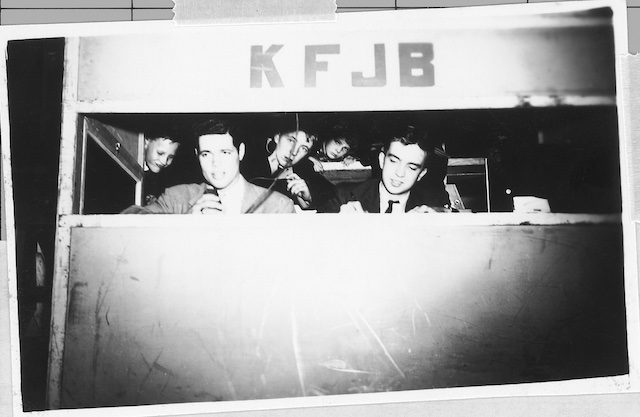
Pioneer Iowa radio station KFJB in Marshalltown was one of the stations that brought its own press box to games, assembling the plywood structure right in the stands so announcers could deliver play-by-play. Often the workings of the broadcast were more fascinating to children in the stands than the game itself, as this photo from the 1940s shows. Photo courtesy of Jeff Stein
May/June 2022 (Volume 14, Issue 3)
By Jeff Stein
The excitement surrounding a high school football game on a fall Friday night, or a winter-time basketball game in the local school gym, can rally a community together like few other events. Following the hometown team, even long after fans have children of their own wearing a uniform, is a strong part of life in Iowa cities large and small.
One of the hallmarks of Iowa radio from its start a century ago has been broadcasting those local games. At first it was designed to help fans track a team on the road, but before long those same fans brought transistor radios to the games themselves, so as not to miss the call of their favorite announcer, who brought the game to life and kept things interesting even if the team’s won-loss record did not meet expectations.
While Marshalltown’s KFJB was not officially licensed until June 2, 1923, the station was broadcasting regularly more than a year before that. Earl Peak and his partner in the Marshall Electric Co., A.J. Curtis, encouraged the efforts of two of their employees in developing an audio receiving station. Merle Easter and Chauncy Hoover had been experimenting with a code signal station in the back of the Marshall Electric building on the corner of 16th and Main streets, then on the west edge of the city. It was taking too long to encode and decode messages, so Easter added a tube to allow audio transmission to take place so he could more quickly communicate with a fellow enthusiast in Ames. The homemade effort soon became one of the first radio stations in Iowa.
Earl Peak had experience working for various rural telephone companies, and had founded Marshall Electric in 1914. In May 1922, the skill of these young men led them to try something new. It seemed like a natural progression to them, but no one had ever tried it before.
Earl’s son Eugene was 10 years old at the time, but had already spent much time hanging around his father’s business. In an interview some three-quarters of a century later, he recalled personally being one of those who helped string an audio line from the business, down West Main Street for three blocks to the new athletic facilities at Franklin Field. Using that audio line, a high school track meet was broadcast — the earliest recorded notation of a live remote broadcast of a sporting event in Iowa, and perhaps the first of a track meet anywhere in the country.
Eugene Peak recalled a similar set up — running the audio line three blocks down the street — which allowed KFJB to broadcast a Saturday high school football double-header on Sept. 23, 1922. The Marshalltown High School Bobcats defeated the Plainsmen of Belle Plaine 32-0 in the first game and then shut out the Toledo Raiders 28-0 in the second game. The broadcasts were noteworthy, in that they were the first live-from-the-field broadcasts of high school football in the United States.
Soon after, KFJB began broadcasting high school football and basketball games throughout the region, using telephone lines to send the signal back to the station — a practice still in common use today. In the days before press boxes, KFJB sports announcers would carry their own “portable press box” to games — sheets of plywood that could be quickly assembled to create a “booth” in the stands to limit the amount of crowd noise that came over the air, and provide some shelter and work space for the announcer.
TO READ THE ENTIRE STORY AND OTHER FASCINATING STORIES ABOUT IOWA HISTORY, subscribe to Iowa History Journal.
